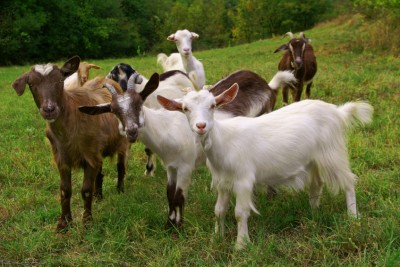One of the cornerstones of any self-sufficient homestead is the ability to produce dairy products.
Dairy products are a valuable source of essential fats, carbs, proteins, vitamins and minerals – including riboflavin, vitamin B12, magnesium and potassium. Unlike fortified and pasteurized milk, however, raw milk is not a significant source of vitamins A and D. Raw milk can be used to make cheese, yogurts, keifers, and butter, adding rich variety to your diet in any self-reliant situation.
Many of us, however, lack the space or have insufficient good pasture for keeping a milk cow. If you don’t have the ability to feed a cow off the land, feed costs can mount quickly. At the height of last year’s drought I watched neighbors selling off cattle or going broke buying hay, if they could find it. I was never so happy to have chosen goats over cows to meet my family’s dairy needs. My goats went along just fine eating dead weeds. We incurred no additional feed costs as a result of the drought, and our milk supply was uninterrupted.
Droughts aside, goats are great on poor pastures, and do fine overwinter on relatively small amounts of feed. Our annual feed expense for a goat herd that fluctuates between 6 and 12 goats runs about two round bales and a few 50 pound sacks of sweet feed. The sweet feed is used primarily as a treat at milking time. Although we have 40 acres, about three quarters of it is not good pasture. It is brushy and wooded, and perfect for goats!
If your ultimate goal is dairy cows, a herd of goats is a great way to clean up overgrown pasture, and is a nice intermediate step. You may find that you enjoy the goats so much that you never make the transition to cows.
Goats are far more economical than dairy cows. You can purchase eight or 10 good dairy goats for the cost of one good Jersey milk cow. You can run more goats in the same space, and we have already discussed the savings in feed costs in raising goats over cows. Feed is a big consideration when planning for a crisis, and goats require little or no planning in this regard.
This book clearly illustrates what an easy and rewarding experience raising goats can be.
Goats are also a lot easier to handle than cows. My daughters, aged 11 and 15, can manhandle the orneriest goat, where a grumpy cow could have its way. This ease of handling is a Godsend at milking time, at kidding time, or at any other time when bending a goat to your will is required. Other than milking time, very little handling is required. Periodic hoof trimming is a good idea, but it is fairly straightforward and an easy skill to learn. Most kidding goes smoothly and nannies almost always handle it on their own. Problem births, however, are easier to handle than those with cows since you don’t have to worry as much about getting stepped on, fallen on, or kicked to death.
We raise a mixture of breeds. Our best milker at the moment is a Lamancha named Snickers. We run her on a once a day milking schedule and she can be counted on for at least a half-gallon per day. Lamancha goats have wonderful dispositions, and the butterfat content is high but not overwhelming. Other goats in our herd are Nubians, Alpines, and crosses of these breeds. Nubians contribute higher fat-content milk, while Alpines are very hardy and good kidders. We have been very pleased with the results of the crosses, although we are leaning more on the Nubian side of the equation at this time. There are many other fine breeds of dairy goats, and you should definitely do your homework before making your selection. If you are very limited in space, several of the miniature breed make excellent milkers, Nigerian dwarfs in particular have extremely high butterfat content in their milk. There is a breed to fit almost any need, preference, or environment.
As I mentioned, we tend to run a once-a-day milking schedule. Opinions vary on this practice. Some maintain that this presents health risks to the goats in the form of a greater likelihood of mastitis. We have not encountered this problem, but we monitor constantly and are prepared to switch to a twice-a-day strategy should the need arise. Another consideration with a once-a-day schedule is that it does reduce milk production. We have weighed the options, and the reduced output is justified by the lightened load on our time at the moment. You will have to make this determination for yourself, but realize that should you choose to milk once a day you are making a commitment to monitor the health of your herd more closely and that there is almost NO flexibility in milking time.
One big minus, to some folks, in goat’s milk is the difficulty in converting it to butter. Even though goat’s milk has a high fat content, it is naturally homogenized. This means that the cream does not separate and making butter requires a lot more effort. We have moved butter production into the “not practical” column, although some folks accomplish the task. Other than that, we use our milk for everything that cow’s milk is good for. This includes morning coffee, chocolate milk for the kids, a variety of cheeses, yogurt, keifer, and even ice cream! Some people find goat’s milk to have a “different” or “goaty” taste, but we have found that this is reduced by using the milk within three or four days, and that after a couple weeks of using goat’s milk you forget it tastes different at all.
Overall, we find keeping goats to be an incredibly rewarding experience, both in tangible and intangible ways. Our goats provide us with abundance far in excess of the demands they place on us, and they are a joy to work or just hang out with. Baby goats are about the cutest critters on the planet, and they are more fun to watch than just about anything on TV these days. When we first got our goats, we viewed them as a temporary stop on the way to a milk cow, but now I wouldn’t trade them for anything. We may still get a cow, but it will be an addition rather than a replacement.
 Off The Grid News Better Ideas For Off The Grid Living
Off The Grid News Better Ideas For Off The Grid Living





